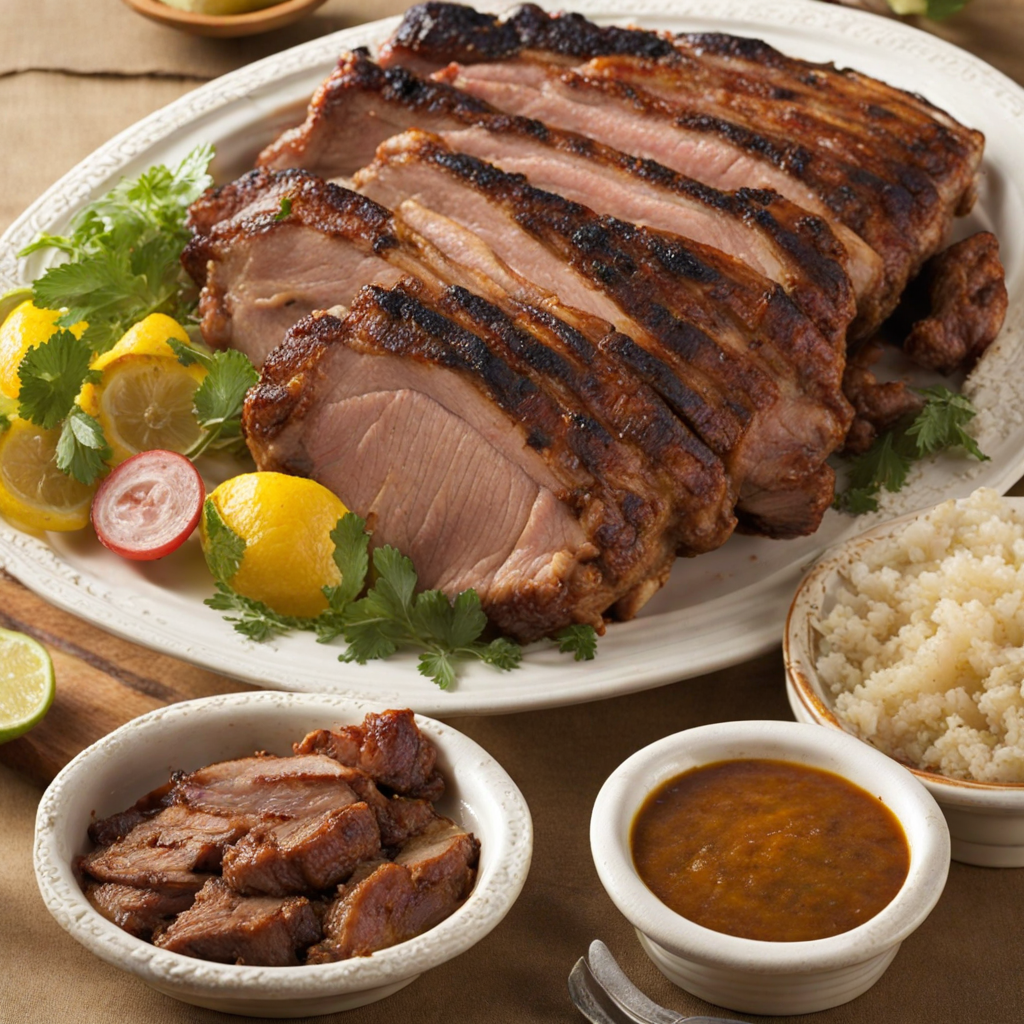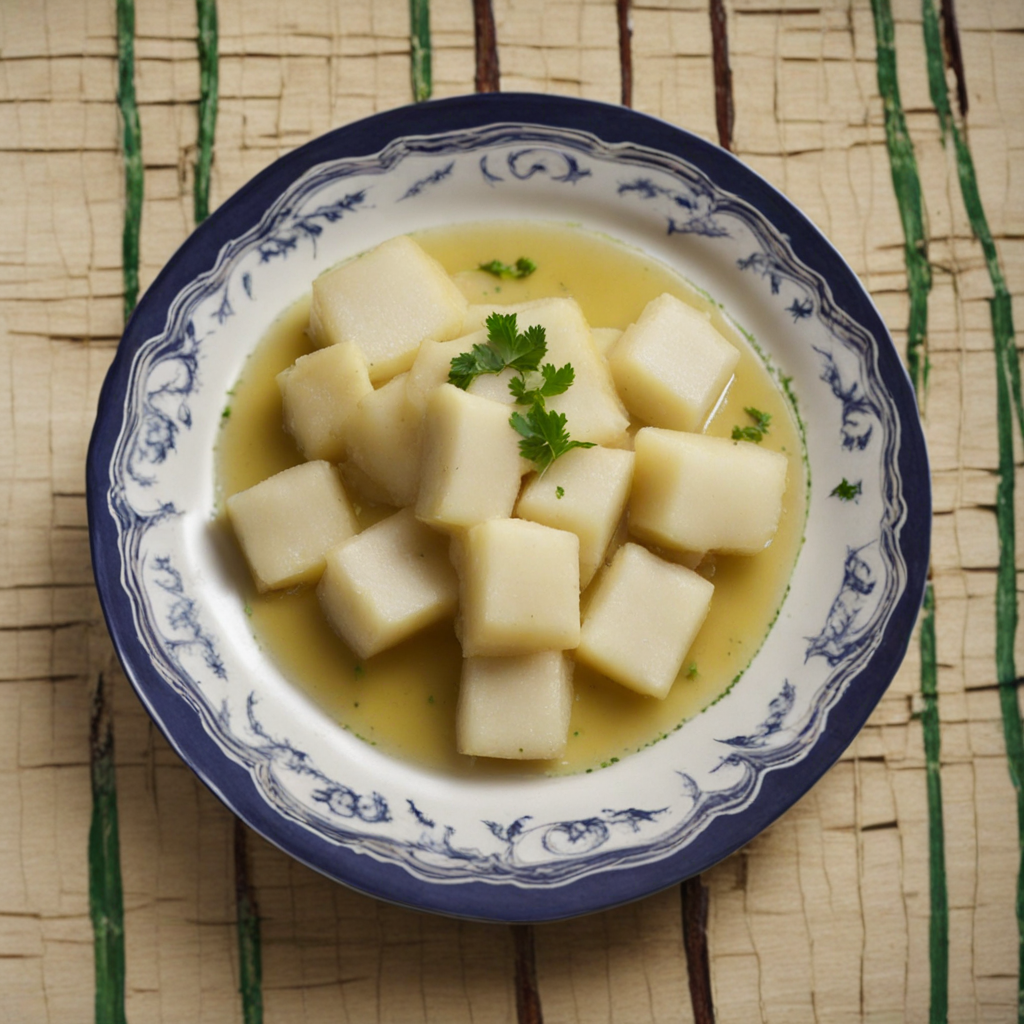Lechón Asado
Lechón Asado is a traditional Cuban dish that revolves around the art of slow-roasting a whole pig, resulting in an incredibly tender and flavorful centerpiece for any gathering. The pig is marinated in a marinade known as "mojo," which typically consists of sour orange juice, garlic, oregano, and cumin, infusing the meat with a tangy and aromatic profile that elevates its natural flavors. The marination process can take several hours, allowing the spices to penetrate deeply into the meat, ensuring that every bite is bursting with flavor. Once marinated, the pig is cooked over an open flame or in a specially designed pit, often referred to as "lechonera." This method of cooking allows the skin to become perfectly crispy and crackling, creating a delightful contrast to the succulent meat underneath. The result is a dish that captures the essence of Cuban cuisine, where the balance of flavors and textures plays a vital role. The aroma of the roasting pig is intoxicating, drawing people together to enjoy the feast and celebrate the communal spirit that surrounds this dish. Served with sides such as rice and black beans, yuca, or plantains, Lechón Asado is not just a meal but a culinary experience that embodies the rich cultural heritage of Cuba. It is often the star of family gatherings, holidays, and celebrations, where the communal aspect of sharing food is deeply cherished. Each bite of the Lechón Asado evokes a sense of warmth and celebration, making it a must-try for anyone looking to explore the vibrant flavors of Cuban cuisine.
How It Became This Dish
The History of Lechón Asado: A Culinary Treasure of Cuba Origins and Early Influences Lechón Asado, the succulent roasted pig that has become a cornerstone of Cuban cuisine, has roots that stretch deeply into the island's indigenous, Spanish, and African heritages. Before the arrival of Europeans, the indigenous Taíno people practiced rudimentary forms of pig roasting, likely utilizing the resources around them to prepare meats in a way that emphasized the natural flavors of the animal. When the Spanish colonizers arrived in the late 15th century, they brought with them a rich culinary tradition that included the use of whole roasted meats. The pig, a staple in Spanish gastronomy, quickly found a place in Cuban kitchens. The introduction of the pig was not only a culinary innovation but also an agricultural one, as the animal adapted well to the island's environment and became widely farmed. The African influence on Cuba's culinary practices cannot be overstated. Enslaved Africans brought to Cuba contributed their own cooking techniques and flavor profiles. This melding of cultures would later influence the way Lechón Asado is seasoned and prepared, incorporating spices and marinades that reflect African culinary traditions. Cultural Significance Lechón Asado is much more than just a dish; it embodies the spirit of celebration and community within Cuban culture. Traditionally served during significant occasions such as Christmas, New Year’s Eve, and family gatherings, this dish symbolizes unity and festivity. The process of roasting a pig is often a communal affair, with family and friends coming together to prepare and enjoy the meal, reinforcing social bonds and cultural identity. In Cuba, the preparation of Lechón Asado typically involves a whole pig marinated in a mixture known as "mojo," which is made from sour orange juice, garlic, oregano, cumin, and other spices. This marinade not only flavors the meat but also serves as a reminder of the island's rich agricultural bounty. The pig is then slow-roasted over an open fire or in a specially designed pit called a "caja china," which allows for the even cooking and infusing of flavors, making it a centerpiece of any festive table. Development Over Time In the early 20th century, as Cuba underwent significant political and social changes, the prominence of Lechón Asado grew as a symbol of national pride. The dish was not only enjoyed at home but also became popular in restaurants and eateries catering to both locals and tourists. The Cuban Revolution of 1959 further solidified its status, as the new government emphasized national identity and cultural heritage amidst the political upheaval. During the 1960s and 1970s, Cuba faced economic difficulties, leading to food shortages and a shift in culinary practices. However, Lechón Asado remained a cherished tradition, often prepared for special occasions despite the challenges. In many households, families would adapt the traditional cooking methods, using whatever resources were available, showcasing the resilience and creativity of Cuban culinary practices. The importance of Lechón Asado transcended borders, especially with the Cuban diaspora in the United States. In cities like Miami, Lechón Asado became an essential part of Cuban-American culture, celebrated at festivals, family gatherings, and restaurants, thereby introducing this culinary treasure to a broader audience. The dish not only served as a reminder of home for many expatriates but also as a point of connection among generations, linking the past with the present. Modern Interpretations and Global Influence As the world becomes increasingly interconnected, Lechón Asado continues to evolve while maintaining its traditional roots. Chefs in Cuba and beyond are experimenting with new techniques and flavors, integrating local ingredients and modern cooking methods. The advent of social media has allowed for a resurgence of interest in this dish, with food bloggers, chefs, and culinary enthusiasts sharing their versions and interpretations online. In Cuba, the rise of private entrepreneurs known as "paladares" has led to a renaissance of traditional Cuban dishes, including Lechón Asado. These privately owned restaurants can offer a more personalized experience, often focusing on high-quality ingredients and innovative takes on classical dishes. The preparation of Lechón Asado in these establishments reflects a commitment to preserving cultural heritage while also appealing to contemporary palates. Furthermore, the global interest in Cuban cuisine has prompted restaurants worldwide to feature Lechón Asado on their menus, showcasing its rich flavors and cultural significance. Food festivals celebrating Cuban culture often highlight this dish, allowing it to be appreciated by diverse audiences. Conclusion Lechón Asado is a dish that tells the story of Cuba's past and present, reflecting the island's complex history and its vibrant culture. From its indigenous roots to its Spanish and African influences, the evolution of Lechón Asado illustrates the power of food as a connector of people and cultures. Today, it stands not only as a culinary delight but as a symbol of community, resilience, and pride among Cubans both at home and abroad. As we savor the rich flavors of Lechón Asado, we partake in a tradition that transcends generations, reminding us of the importance of family, celebration, and the stories that food can tell. This beloved dish continues to evolve, ensuring that its legacy endures for future generations, keeping the spirit of Cuba alive in every bite.
You may like
Discover local flavors from Cuba







